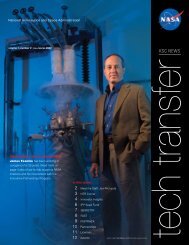2006-2007 - Kennedy Space Center Technology Transfer Office
2006-2007 - Kennedy Space Center Technology Transfer Office
2006-2007 - Kennedy Space Center Technology Transfer Office
- No tags were found...
You also want an ePaper? Increase the reach of your titles
YUMPU automatically turns print PDFs into web optimized ePapers that Google loves.
Particle Ejection and Levitation <strong>Technology</strong> (PELT)Each of the six Apollo landers touched down at unique sites on the lunar surface. AsideLunar Launch/Landing Site from the Apollo 12 landing site located 180 meters from the Surveyor III lander, plumeEjecta Mitigation impingement effects on ground hardware during the landings were not a problem. Theplanned return to the Moon requires numerous landings at the same site. Since the topfew centimeters of lunar soil are loosely packed regolith, plume impingement from the lander willeject the granular material at high velocities. Figure 1 shows what the astronauts viewed from thewindow of the Apollo 14 lander. There was tremendous dust excavation beneath the vehicle. Withhigh-vacuum conditions on the Moon (10 –14 to 10 –12 torr), motion of all particles is completelyballistic. Estimates derived from damage to Surveyor III caused by the Apollo 12 lander showthat the speed of the ejected regolith particles varies from 100 m/s to 2,000 m/s. It is imperativeto understand the physics of plume impingement to safely design landing sites for future Moonmissions.Aerospace scientists and engineers have examined and analyzed images from Apollo video extensivelyin an effort to determine the theoretical effects of rocket exhaust impingement. KSC has joined theUniversity of Central Florida (UCF) to develop an instrument that will measure the 3-D vectorof dust flow caused by plume impingement during descent of landers. The data collected from theinstrument will augment the theoretical studies and analysis of the Apollo videos.Instrumentation designs and concepts were tested in a custom-designed wind tunnel that allows abed of granular material to be eroded. The material erosion can be measured from altitudes similarto those at which the lunar erosion first begins: up to 30 m. The wind tunnel chamber operates atatmospheric pressure; however, ρV 2 (one of the important scaling parameters) is approximatelythe same as those for the lander cases on the Moon. Figure 2 shows yellow quartz sand flowing in asection of the wind tunnel. Figure 3 shows 2-D flow calculations of a scene similar to that shown inFigure 2.The instrument can also measure other lunar surface dust effects, such as dust levitated by solarcharging. Though most of the effort for the current instrument has been focused toward lunarapplications, the instrument is quite general and could easily be adapted to other applications such asMartian landings.Figure 1. Example view taken during descent of Apollo lander. The dustis eroding from the lower left to the upper right.30 <strong>Space</strong>port Structures and Materials













